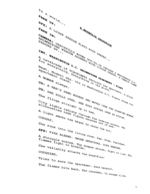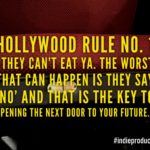Indie Filmmakers and the Proverbial Promo

In today’s independent filmmaking world, where indie filmmakers struggle to get their projects funded, the never-ending debate goes on as to whether or not to produce a promo for their as-of-yet un-produced project.
In the ’80s and ’90s, when the idea of producing promos for a small project was starting to flourish in the indie film community, it was cost-prohibitive to produce a short to promote financing a feature film.
Motion picture film was really the only viable medium in those decades, as that digital revolution had only reached music and LaserDisc. In fact, I do not recall seeing any promos produced for indie feature films back in those days. That does not mean there were not any produced, but I seem to recall filmmakers just went ahead and used their limited funds to produce a short, if they did not have enough money to produce a feature.
“Do I produce a promo? Or, not?”
Take a look at what Robert Townsend did with Hollywood Shuffle. Ho’s gotta eat, too.
Since the second to last digital revolution – the advent of small high-end digital tools – it has practically become the norm to produce a trailer or, short to promote a project in hopes of securing financing. Good or bad, this seems to be the current modus operandi for indie filmmakers.
Digital film and jumbo shrimp
As a side note, I’ve always believed since we (as filmmakers) have moved away from editing celluloid film, to editing on digital workstations, we not only have the ability to try a multitude of options, theories, or creative ideas in editing, but it opens the door to indecision. Read that as editing-re-editing, over and over with no artistic benefit. And, frequently ending in frustration.
Flash forward to an industry event I attended a couple of months ago during the Jazz and Heritage Foundation’s Jazz Festival at the New Orleans Museum of Art. Sync Up Cinema was put on by NOVAC, and the New Orleans Film Society. A New York-based manager for writers and directors, Will Rowbotham with Prolific Entertainment, said he would always look at a short, teaser, trailer (call them promos) if someone presented him one. Now, he did qualify his statement in that he felt he was the exception, rather than the rule. He said he was always looking for those projects others would not look at or, just skipped-over.

As a practical business exercise, if I was presented two projects to look at and I could only choose one, Door No. 1 or Door No. 2, I would certainly choose the one with the promo video. I surmise most people would choose to watch the promo. Read ‘most people’ as your prospective audience.
To produce? Or, not produce? That is the question
With everything I have noted above and experienced in my career, my current opinion on indie filmmakers producing a promo to get their film project financed is a resounding YES – do it.
The tools and technology are too inexpensive. The demand by audiences for good content (‘good’ being the operative word) is growing and growing. However, the talent (from producing, directing, editing, acting, etc., etc., etc.) is THE wildcard. People either have it or not.

That statement does not mean they could not gain the talent, it just means you need the right combination to make the promo a success. THAT is the metal of what makes an indie producer. Unfortunately, in this business, this process does not always equate to a successful sale.
Going back to my theory above about editing, this opens the door to everyone who has a credit card and buys a camera and editing system, to produce a promo for their project. Just look at YouTube and you will see hundreds of thousands of promo videos, ostensibly some produced for the specific use in securing financing for those particular projects. Or, even getting exposure out to prospective agents. Shhh. Agents troll YouTube for talent. It is their big-little secret.
I am fortunate enough in my career to have worked with some of the best commercial producers and editors, top feature film trailer producers and editors, and a whole team of top promo producer and editors. Having seen excruciating debates (read that as arguments) over the color of a font, to the timing of an edit, to a sound mix, to the way a doll’s hair was combed, etc., etc., etc. Yes. A toy doll’s hair. I tend to think of it as earning my battle ribbons. Scars included.
Those experiences have given me the opportunity to work on and collaborate with wonderfully-talented artists on various projects, which are essentially designed to get an audience to buy a product or, buy entertainment. The pressure is extremely high on these folks to deliver a promo which gives the client a calculated and intended result.
The trailer produced for a motion picture/feature film is specifically designed to get butts in the seat. Well, let me re-phrase that. To get an audience to spend money – buy tickets, DVDs, VOD, digital media – on that particular film. Whether or not those butts actually make it to the seat is another debate, or argument to be made another day. Don’t let the fear of having to compete with these professionals prevent you from producing your promo. Produce. It.
You say potato, I say pizza
Terminology is specific in our industry and as an indie filmmaker, or an aspiring filmmaker, using the right terminology can ultimately decide whether or not people take you seriously as a professional.
Commercial Spot
A commercial spot is self-explanatory – a TV spot of typically :30, :60, :15, :10 and, yes, :05 seconds in length.
Teaser
A teaser is short in nature, typically less than :60 seconds and, well, teases the project. It does not give your audience enough satisfaction other than to entice their INTEREST in seeing more.
Trailer
A trailer (coming from the Golden Era of Hollywood terminology; followed the feature presentation) now days of course, comes before the main event. A trailer is typically 90-120-150 seconds in length and tells more of the story, so an audience gets an idea of what the story is about. In technical parlance, a trailer is commonly called a LIE. Ha! How many trailers have you seen, when after actually seeing the movie, you said to yourself, “Self? That movie sucked. The trailer was better.” I rest my case.
Promo
A promo is of varying lengths. You name it. A promo – short for promotional video – is typically what people are really talking about when they want to produce a short to promote their project. Whether they are looking to establish a relationship with business partners, or secure financing, looking for an agent, etc., or, the indie filmmaker is experimenting with how to craft their story, a promo video is desirable in today’s market.
Tips, tricks and how to rob a bank
As anecdotal evidence and as serious scientific studies have crossed paths with me over the years on the viewing habits of audiences, I have whittled-down a few simple rules for producing promos for your feature film, new media project, documentary, or even series. If you ask me to cite my studies, I will point to my baldheaded coconut and say, “I think it’s up there.”
Length
Do not produce anything longer than 8-10 minutes. Aim for 5-7 minutes. I have found in my own research that audiences have been trained by TV over the years, commercial breaks come between 7-8 minutes for short segments, to 8-10 minutes for longer segments in TV shows. The next time you are watching your favorite TV show, time the segments, time the commercial spots and layout a timeline to give yourself a better picture as to how audiences have been ‘trained’ over time. Or, maybe it is our bladders that have been evolutionarily-changed.
Camera
Nobody cares you shot with the R3D Camera. I repeat. Nobody cares. Okay. The Director of Photography (DP) cares. With that being typed, I am not arguing to ‘not’ use a R3D Camera if your promo budget allows. With a talented director, talented producer, talented DP and talented Production Sound Mixer/Recordist, an enticing promo can be produced on a smartphone camera, which can beat a R3D Camera any day in the hands of UN-talent. In short, don’t blow your budget on the camera rental when you can feed your crew better. Or, at all. And, let us not forget to feed the actors.
Sound
George Lucas launched his THX empire certifying movie screens and sound systems back in 1983 with the release of Star Wars: Revenge of the Jedi (“Return” I’m still reeling from selling my “Revenge” poster) with these words, “For the past 35 years, motion picture loudspeaker systems have not changed…”

Terrytown, Louisiana
Little did I know in 1983, tearing tickets at a movie theater, one day I would design, engineer and build in the late twentieth century, the world’s first THX-certified digital cinema with a wonderfully talented team. Digital cinema was new then. Blasé, now.
Sound is just as important as picture. Audiences today expect more, including your Aunt Lucy. The sad part of audiences today is you can have horrible photography and claim it is ‘avant garde’ but, if your sound is horrible, people will tune you out. They expect horrible picture and sound quality from YouTube videos, not promos. Hire a skilled and talented Production Sound Recordist/Mixer, or, at least someone who has a very good grasp of what needs to be accomplished.
Editing
No matter how much quality goes into the imagery and sound of a project, without a talented editor who can tell the story – you, as the filmmaker need told – you have nothing but large video files on a hard drive crying-out for expressive freedom.
Unless you are writing, directing, producing, shooting, acting and editing everything (if you are still alive), your best bet is to hire, or, barter with a skilled and talented editor to tell the story in the time allotted.
Free
When you post that ad to Craigslist.org looking for crew from all departments to work on a special project with wonderfully talented people and an A-List actor (who you can’t name at the moment), which is being looked at by numerous agents (who you can’t name at the moment), remember you are asking people to work for FREE on YOUR project.
The only thing these people can receive in return is experience and hopefully something better than pizza three times a day. Yes, I worked on a project where we were fed Domino’s Pizza three times in one day. The crew walked by lunchtime to go eat elsewhere. The seagulls got the pizza.
Your crew is your most valuable resource – not your actor or, script. My apologies to screenwriters and actors. The only exception I can honestly see is if you feed the crew very well, keep the hours down to 6-hours per day and you pay for all their expendables and gas.
If you can’t afford those simple things, you should re-evaluate your project as you are likely to burn every bridge you built to get a crew on that set.
I always got the largest student crews, which included the Dean of my film school – Columbia College Hollywood – to come work for FREE on my student films. The key? I made a deal with the caterer at the studio where I was working during film school, to caterer my weekend shoots. The caterer added my food orders to those of our clients, such as Paramount, Warner Bros., etc. and probably pocketed the cash I gave him.
I would like to thank The Academy, er, Paramount and Warner Bros. for feeding my student film crews on all those projects. I asked the Dean once, “Why do you always come to my shoots? Am I in trouble or something?” He replied, “No. You always have the best food.” I rest my case.
Promotion
Show anyone and everyone on this Big Blue Marble your promo once it is finished. Whether or not that audience is your Aunt Lucy, or, a prospective business partner, a lone promo’s scream from the deep vast woods will not be heard.
Concentrate on the story and what scene, or scenes, in the script would give the feel of the project and relate the story to a typical audience. You could even write a scene or scenes which may not make it in the final feature film, if you get that far.
Do not produce a promo thinking your audience is as sophisticated as investors from Wall Street. Produce a promo for the average movie-going audience. While there might not be many average movie-going 18-34-year-olds who have a few million to invest in independent filmmaking, producing a promo so that a prospective investor and your Aunt Lucy can understand, enjoy and get behind, is one of the most important aspects of the business-side of an indie filmmaker.
Let your dreams be your only limit.
Good luck!
– Stan



!["Crazy Bitches" (2014) [Courtesy Crazy Bitches]](https://stanleybgill.com/21/08/wp-content/uploads/2020/04/crazy-bitches-2014-150x150-1.jpg)






